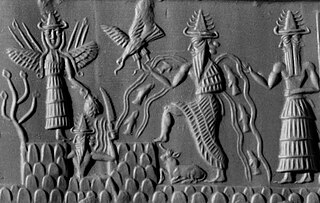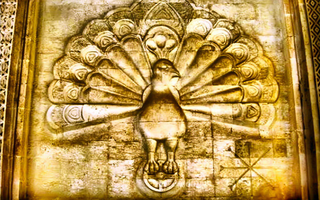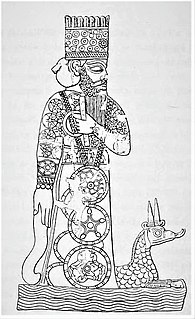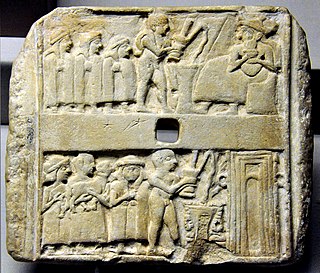 W
WMesopotamian religion refers to the religious beliefs and practices of the civilizations of ancient Mesopotamia, particularly Sumer, Akkad, Assyria and Babylonia between circa 3500 BC and 400 AD, after which they largely gave way to Syriac Christianity. The religious development of Mesopotamia and Mesopotamian culture in general, especially in the south, was not particularly influenced by the movements of the various peoples into and throughout the area. Rather, Mesopotamian religion was a consistent and coherent tradition which adapted to the internal needs of its adherents over millennia of development.
 W
WAkitu or Akitum is a spring festival held in the first month of Nisanu in ancient Mesopotamia, to celebrate the sowing of barley. The Babylonian and Assyrian Akitu festival has played a pivotal role in the development of theories of religion, myth and ritual. While the purpose of the festival remains a point of contention among both historians of religion and Assyriologists, it is certain to have played a pivotal role in the regular setting of an agenda, priorities, and in the overall advancement of Western Civilization as being one of the first regularly occurring forums where proposals for social maintenance or change could consistently be made and crucial issues readily addressed.
 W
WThe ancient Mesopotamian underworld, most often known in Sumerian as Kur, Irkalla, Kukku, Arali, or Kigal and in Akkadian as Erṣetu, although it had many names in both languages, was a dark, dreary cavern located deep below the ground, where inhabitants were believed to continue "a shadowy version of life on earth". The only food or drink was dry dust, but family members of the deceased would pour libations for them to drink. Unlike many other afterlives of the ancient world, in the Sumerian underworld, there was no final judgement of the deceased and the dead were neither punished nor rewarded for their deeds in life. A person's quality of existence in the underworld was determined by their conditions of burial.
 W
WBabylonian religion is the religious practice of Babylonia. Babylonian mythology was greatly influenced by their Sumerian counterparts and was written on clay tablets inscribed with the cuneiform script derived from Sumerian cuneiform. The myths were usually either written in Sumerian or Akkadian. Some Babylonian texts were translations into Akkadian from the Sumerian language of earlier texts, although the names of some deities were changed.
 W
WUsed by Sumerians and other Mesopotamian cultures beginning in the third millennium BC, clay nails, also referred to as dedication or foundation pegs, cones, or nails, were cone-shaped nails made of clay, inscribed with cuneiform, baked, and stuck into the mudbrick walls to serve as evidence that the temple or building was the divine property of the god to whom it was dedicated. Versions were also made of metal, including castings with figurative designs, such as the Hurrian foundation pegs.
 W
WThe E-ninnu 𒂍𒐐 was the E (temple) to the warrior god Ningirsu in the Sumerian city of Girsu in southern Mesopotamia. Girsu was the religious centre of a state that was named Lagash after its most populous city, which lay 25 km southeast of Girsu. Rulers of Lagash who contributed to the structure of the E-ninnu included Ur-Nanshe of Lagash in the late 26th century BC, his grandson Eannatum in the following century, Urukagina in the 24th century and Gudea, ruler of Lagash in the mid 22nd century BC.
 W
WE-sara (Cuneiform: E2 SAR.A 𒂍𒊬𒀀 "House of the Universe"), was the temple dedicated to Inanna in Uruk by Ur-Nammu (reigned c. 2112 BC – 2094 BC).
 W
WE-anna was an ancient Sumerian temple in Uruk. Considered "the residence of Inanna" and Anu, it is mentioned several times in the Epic of Gilgamesh, and elsewhere. The evolution of the gods to whom the temple was dedicated is the subject of scholarly study.
 W
WEhursag is a Sumerian term meaning "house of the mountains".
 W
WEnamtila is a Sumerian term meaning "house of life" or possibly "house of creation". It was a sanctuary dedicated to Enlil, likely to have been located within the Ekur at Nippur during the Akkadian Empire. It also referred to various other temples including those to later versions of Enlil; Marduk and Bel as well as one to Ea. It was likely another name for Ehursag, a temple dedicated to Shulgi in Ur. A hymn to Nanna suggests the link "To Ehursag, the house of the king, to the Enamtila of prince Shulgi we go!" Another reference in the Inanna - Dunmuzi text translated by Samuel Noah Kramer references the king's palace by this name and possibly makes references to the "sacred marriage": "In the Enamtila, the house of the king, his wife dwelt with him in joy, in the Enamtila, the house of the king, Inanna dwelt with him in joy. Inanna, rejoicing in his house ...". A fire is reported to have broken out next to the Enamtila in a Babylonian astronomical diary dated to the third century BC. The Enamtila is also referred to as a palace of Ibbi-Sin at Ur in the Lament for Sumer and Ur, "Its king sat immobilised in his own palace. Ibbi-Suen was sitting in anguish in his own palace. In E-namtila, his place of delight, he wept bitterly. The flood dashing a hoe on the ground was levelling everything."
 W
WDeities in ancient Mesopotamia were almost exclusively anthropomorphic. They were thought to possess extraordinary powers and were often envisioned as being of tremendous physical size. The deities typically wore melam, an ambiguous substance which "covered them in terrifying splendor" and which could also be worn by heroes, kings, giants, and even demons. The effect that seeing a deity's melam has on a human is described as ni, a word for the "physical creeping of the flesh". Both the Sumerian and Akkadian languages contain many words to express the sensation of ni, including the word puluhtu, meaning "fear". Deities were almost always depicted wearing horned caps, consisting of up to seven superimposed pairs of ox-horns. They were also sometimes depicted wearing clothes with elaborate decorative gold and silver ornaments sewn into them.
 W
WEidiki Katastaltiki Antitromokratiki Monada
 W
WThe Statue of Marduk, also known as the Statue of Bêl, was the physical representation of the god Marduk, the patron deity of the ancient city of Babylon, traditionally housed in the city's main temple, the Esagila. There were seven statues of Marduk in Babylon, but 'the' Statue of Marduk generally refers to the god's main statue, placed prominently in the Esagila and used in the city's rituals. This statue was nicknamed the Asullḫi and was made of a type of wood called mēsu and covered with gold and silver.
 W
WSumerian religion was the religion practiced and adhered to by the people of Sumer, the first literate civilization of ancient Mesopotamia. The Sumerians regarded their divinities as responsible for all matters pertaining to the natural and social orders.
 W
WÉ is the Sumerian word or symbol for house or temple.
 W
WUtu, later worshipped by the East Semitic Akkadian-speaking Babylonians as Shamash, was the ancient Mesopotamian sun god, god of justice, morality, and truth, and the twin of the Mesopotamian goddess Inanna, the Queen of Heaven. His main temples were in the cities of Sippar and Larsa. He was believed to ride through the heavens in his sun chariot and see all things that happened in the day. He was the enforcer of divine justice and was thought to aid those in distress. According to Sumerian mythology, he helped protect Dumuzid when the galla demons tried to drag him to the Underworld and he appeared to the hero Ziusudra after the Great Flood. In the Epic of Gilgamesh, he helps Gilgamesh defeat the ogre Humbaba.
 W
WYazidism or Sharfadin is a monotheistic ethnic religion that has roots in a western Iranic pre-Zoroastrian religion directly derived from the Indo-Iranian tradition, although other, less common and more outdated narratives link the religion to Zoroastrianism and even Ancient Mesopotamian religions. Yezidism is followed by the mainly Kurmanji-speaking Yazidis and is based on belief in one God who created the world and entrusted it into the care of seven Holy Beings, known as Angels. Preeminent among these Angels is Tawûsê Melek, who is the leader of the Angels and who has authority over the world.